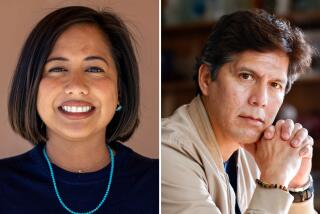Redistricting and Deep Rifts in L.A. Politics
The Los Angeles City Council’s debate Tuesday over school district boundaries shows how deeply racial and class divisions have infected L.A. politics.
The council took more than three hours to approve the controversial redistricting plan, which takes away one Board of Education seat from the San Fernando Valley to create a district designed to put a second Latino on the five-member board. Its main backer was Councilman Richard Alatorre, from the Latino Eastside.
The Valley opposed Alatorre’s plan.
Although this vast community of more than 1 million has changed greatly since it came to epitomize L.A. suburbia, it still reflects the character of the middle-class homeowners who settled there beginning in the 1940s. Once almost all white, Valley residents now include blacks and Latinos who share a belief in a Valley way of life.
Aligned against them were the representatives of urbanized older inner-city and mid-town neighborhoods where black and white residents have been joined by immigrants from Mexico, Central America and Asia.
Speaking for the Valley, Chamber of Commerce representative Robert Scott charged that advocates of the pro-Latino redistricting plan were “trying to destroy non-Latino districts.”
An African-American speaker from the Valley said that black students are treated badly when they attend schools where Latinos are in the majority. Valley schools, he said, should not be “hooked up with Tijuana.”
That drew an embittered reply from Councilman Mike Hernandez, who represents poor Latino neighborhoods stretching from Dodger Stadium down to the Santa Monica Freeway. Hernandez, still angry over what he regards as official neglect of his immigrant neighborhoods during the riot, said “the majority of us here (ethnic minorities) are treated as an underclass.”
After listening to the debate, Councilwoman Rita Walters, who is African-American, said it reaffirmed for her the accuracy of the work of the late Swedish social economist Gunnar Myrdal, who wrote half a century ago that race affects every aspect of American life.
Racial tensions had been building on the council for more than a year over the same issues that polarized neighborhoods outside City Hall.
The issue that set it off was the Rodney G. King beating. Black council members, joined by Councilman Michael Woo, demanded Daryl F. Gates’ resignation as police chief. Alatorre hung back and white council members were either pro-Gates or ambivalent.
Adding to the tensions was an unrelated argument over city finances. As L.A.’s fiscal situation worsened, Finance Committee Chairman Zev Yaroslavsky led an assault on the large treasury of the city’s Community Redevelopment Agency.
This body, run by a mayoral-appointed board, has control of hundreds of millions of dollars, revenues from projects such as the long-term rebuilding of downtown L.A. Pretty much immune from council control, the CRA spent the money as it wished.
A substantial amount of its funds were used to help finance housing and commercial projects in black and Latino sections of the city. When Yaroslavsky and other white council members tried to tap the CRA treasury for the Police and Fire departments and other city services, Alatorre and other minority council members resisted. Privately, they said the assault on the CRA amounted to an attack on poor people, and was tinged with racism.
As Tuesday’s debate began, Alatorre’s redistricting plan was one vote short. But in the end, it received nine votes, two more than needed. Old-fashioned politicking was responsible.
Yaroslavsky switched because he became convinced that the Valley-supported plan would hurt his Westside base by eliminating a West L.A. school board district now represented by Mark Slavkin.
The other switcher was Council President Pro Tem Marvin Braude, a supporter of the Valley who was opposed to Alatorre’s plan. Braude was standing in for President John Ferraro, hospitalized while recovering from heart surgery. Ferraro, whose Mid-Wilshire district is increasingly Latino, had helped Alatorre put together his plan.
Before the debate began, Ferraro placed a call from his hospital room to Braude, who was in Ferraro’s chair on the dais. He asked Braude to back the Alatorre plan. The debate had lasted too long, he said, and was becoming too poisonous. Braude agreed.
It was just a temporary respite. Similar disputes are sure to break out on other issues. The depth of the divisions was clear, as was the complexity.
That was the lesson of the debate. It was a reminder of the difficulty of finding peaceful political solutions in a city trying to come to grips with its great differences.
More to Read
Sign up for Essential California
The most important California stories and recommendations in your inbox every morning.
You may occasionally receive promotional content from the Los Angeles Times.










